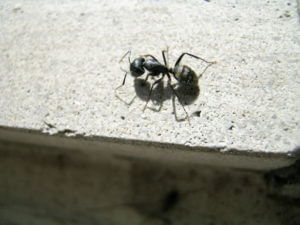Pavement Ants
Quick Stats
- Latin Name: Tetramorium caespitum
- Size: Very small at 2-2.5mm in length
- Color: Light brown to black with whitish parallel lines running from their head to their thorax
- Shape: Their midsection (“club”) is 3-segmented and their long antennae have 12 segments each. Pavement ants also have a set of pincers that extend about halfway to the end of their antennae.
- Found in: Common in the Northeast, particularly in Massachusetts and Pennsylvania. Also extend to California and most of the Midwest as well as parts of the south down to Tennessee.
- Overview: Pavement ants are indiscriminate eaters and will nest just about anywhere they can find shelter from the elements and predators. They’re a common household nuisance and are often mistaken for black ants.
About Pavement Ants
 Pavement ants are a hungry, hungry species. They’ll invade any kind of dwelling in search of a food source and they eat everything from sweet sugars to meat to grease. They will also eat other insects if possible. Pavement ants got their name from their tendency to set up their short-term nests in the cracks between pavement.
Pavement ants are a hungry, hungry species. They’ll invade any kind of dwelling in search of a food source and they eat everything from sweet sugars to meat to grease. They will also eat other insects if possible. Pavement ants got their name from their tendency to set up their short-term nests in the cracks between pavement.
Because they’re highly territorial, Pavement ants can sting and bite. Though they usually don’t cause an allergic reaction they live in large numbers so you’re advised to use caution when approaching a suspected nest. Most colonies include multiple queens and thousands of workers. Because the species is somewhat sensitive to moisture and temperature new broods are moved around in infancy to keep them safe until conditions improve.
Signs of Pavement Ants in Your Home
Most homeowners experience a problem with Pavement ants outdoors rather than indoors. The first sign of a Pavement ant infestation is usually the refuse of a colony dig: Small piles of soil on the sidewalk or patio. If it’s possible, removing a stone from the suspected nest area should reveal hundreds of moving ants and tell you definitively whether you’ve got an issue. Swarms or strings of moving ants is also a good indication you may have a colony living on your property.
Because these ants can be aggressive it’s recommended you bring in a professional to deal with eradicating their colonies. Multiple colonies can be present in one location and it’s often difficult to tell where one stops and another begins. At-home treatments are usually less than effective at remedying Pavement ants as their nests are usually deep enough to avoid long-term damage from topical solutions.
Call an ant professional in your area now to find out if you have an issue with Pavement ants. Getting rid of this home pest starts with identifying their nests which is easier said than done.

